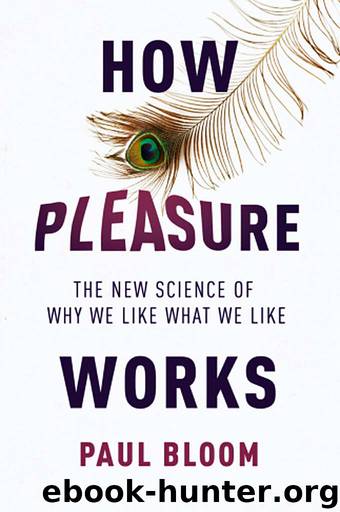How pleasure works by Paul Bloom

Author:Paul Bloom [Bloom, Paul]
Language: eng
Format: epub
DISPLAYS AND FITNESS
Here are some reasons one might value a painting:
1. It could be attractive in a low-level way; the patterns might please the eye.
2. It could resemble something attractive, like colorful flowers or a beautiful face.
3. It might be familiar. This is the mere exposure effect: up to a point, familiarity breeds pleasure.
Does mere exposure really work for paintings? The psychologist James Cutting asked why some French impressionists are preferred to others. In one study, he found that adults, but not children, typically prefer paintings that have been frequently published in the last century over those that are more obscure.
Of course, this might not be an effect of familiarity. Maybe it’s the other way around:
Perhaps the paintings that are frequently published are better than the rest, and the adults are responding to this superior quality, not the frequency. Cutting tested this in a second study in which he presented the more obscure impressionists to his undergraduate class on visual perception, showing them for a few seconds each, without any comment, as part of PowerPoint presentations on other topics. Then he tested his students at the end of the semester, asking which paintings they liked the most. It turns out that this brief exposure flips the normal preference pattern. Now they prefer these obscure paintings to more famous ones, just because of the brief exposures. Simply seeing a painting, then, makes you like it more.
4. It might be associated with a positive memory. This matters a lot for photographs, which display experiences such as weddings, graduations, and reaching the top of Mount Everest.
5. It might nicely complement a room. (After all, the shape of a painting does influence its price.)
6. It might enhance your status, impressing those who see that you own it. A painting of Christ on the cross or of the Sabbath table advertises your piety. A modernist work shows how much you know about and care about art. A provocative piece can signal religious or sexual sophistication. And an original by a famous artist is an easy and nonblatant way of telling everyone how rich and successful you are. There is certainly pleasure in that.
7. It might gain value from positive contagion.
As discussed in the last chapter, the mere fact that an object has touched someone famous and esteemed can enhance its value.
This list misses a critical factor, though. We are also interested in how paintings are created, and we get pleasure from what we infer to be the nature of that creative process.
This is the view that the philosopher Denis Dutton defends in his important book, The Art Instinct. For Dutton, part of the appeal of works of art is that they serve as “Darwinian fitness tests.” He develops this claim in the context of a sexual selection theory of the origin of art, one proposed originally by Darwin and then extended and proposed originally by Darwin and then extended and developed by the psychologist Geoffrey Miller, whose work we discussed earlier in the context of sex.
Download
This site does not store any files on its server. We only index and link to content provided by other sites. Please contact the content providers to delete copyright contents if any and email us, we'll remove relevant links or contents immediately.
Should I Stay or Should I Go? by Ramani Durvasula(7523)
Why We Sleep: Unlocking the Power of Sleep and Dreams by Matthew Walker(6563)
Fear by Osho(4625)
Flow by Mihaly Csikszentmihalyi(4585)
Rising Strong by Brene Brown(4348)
Why We Sleep by Matthew Walker(4322)
The Hacking of the American Mind by Robert H. Lustig(4271)
How to Change Your Mind by Michael Pollan(4261)
Too Much and Not the Mood by Durga Chew-Bose(4236)
Lost Connections by Johann Hari(4009)
He's Just Not That Into You by Greg Behrendt & Liz Tuccillo(3811)
Evolve Your Brain by Joe Dispenza(3578)
The Courage to Be Disliked by Ichiro Kishimi & Fumitake Koga(3356)
Crazy Is My Superpower by A.J. Mendez Brooks(3277)
In Cold Blood by Truman Capote(3274)
Resisting Happiness by Matthew Kelly(3270)
What If This Were Enough? by Heather Havrilesky(3254)
The Book of Human Emotions by Tiffany Watt Smith(3203)
Descartes' Error by Antonio Damasio(3194)
